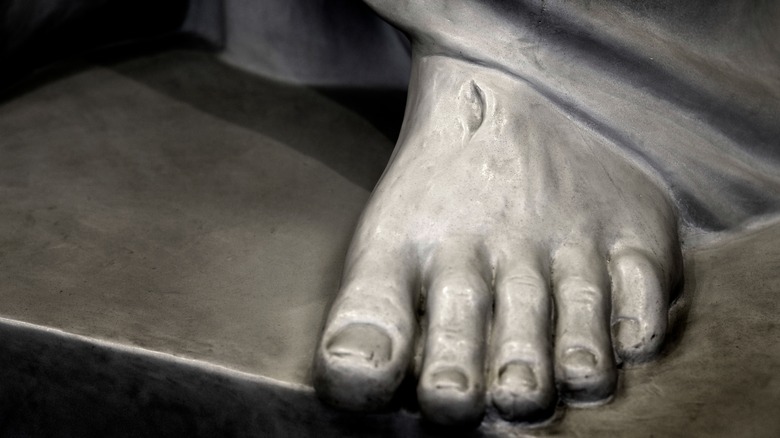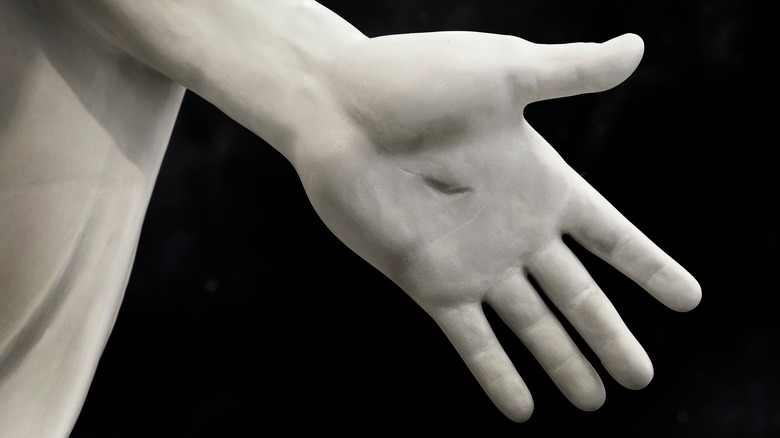What It Really Means To Have Stigmata
Religion can sometimes have effects on people that transcend the ordinary experiences of belief, such as the sense of belonging to a community, the attachment to something larger than one's self, the comfort and peace brought found in a higher power. Some devotees, however, take things a step further. For example, some Christians in parts of the Southern United States handle snakes as part of their worship (per CBS News), and sometimes they're bitten and suffer no ill effects (and sometimes they're bitten and suffer and die horribly). Some Filipino Christians even recreate Jesus' crucifixion, to the point of being nailed to crosses, a practice from which the Catholic Church has tried to distance itself, according to Reuters.
Over the past 900 or so years, according to Kenyon College, some 300 or so people are generally believed, by the Catholic Church anyway, to have experienced stigmata. A stigmata is when a believer exhibits the wounds of Christ somewhere on their bodies, without having inflicted it themselves. It could be psychosomatic, it could be overactive imaginations combined with religious wishful thinking, although to some people of faith, stigmata is not only real, but a manifestation of Christ's presence in the believer.
The wounds of Christ
According to the accounts of Jesus' crucifixion all four Gospel accounts (via KJV Bible Online), Jesus likely experienced six specific wounds during the event. Consistent with most crucifixion victims, nails were driven into each of his two hands, or possibly his wrists or even forearms, fastening him to a cross. Nails were also driven into each of his two feet (whether the same nail was driven though both feet, or if there was a nail for each foot, is lost to history); and, according to John's account, after he died, a Roman soldier pierced Jesus' side with a spear, from which blood and water flowed. Earlier in the account, Jesus was given a crown of thorns in an act of mockery, and that would have also likely wounded him on his head.
As Kenyon University explains, a stigmatic — a person who claims to be experiencing stigmata — claims to experience suffering from those identical wounds of Jesus on themselves, such as a searing pain. Others experience visual manifestations of these wounds, such as bleeding from where Christ would have been injured.
Stigmatics don't consider any of this a bad thing, according to Live Science. "Stigmatics ... do not see their affliction as a terrifying menace but instead as a miraculous blessing — a sign that they have been specially chosen by God to suffer the same wounds his son did," writes Benjamin Radford.
Padre Pio, Exhibit A For Stigmata
Christianity, as a religion, dates to the first century A.D. However, it would take well over a millennium before any Christians started claiming to experience stigmata, as Live Science explains. Or at least, it would be 1,200 years before anybody experienced stigmata and wrote it down. Specifically, the first recorded stigmatic was St. Francis of Assisi who, according to Britannica, manifested the wounds about two years before his death.
St. Francis may have been the first, but the most famous stigmatic, according to Live Science, was an Italian priest named Francesco Forgione (1887-1968), better known as Padre Pio, or Pio of Pietrelcina. According to an article posted by Catholic broadcaster EWTN, Padre Pio received the stigmata one day while praying, but declined to tell anyone about it until later. It appears as if the Catholic Church has concluded that Pio's alleged stigmata was real — he was canonized; that is, declared a saint — by Pope John Paul II in 2002. It bears noting that when Padre Pio was canonized, the Vatican didn't mention his stigmata at all, according to The Guardian. Further, evidence exists that Pio may have copied another stigmatic's accounts — a claim Pio denied. The founder of Milan's Catholic University of the Sacred Heart, Father Agostino Gemelli (who was also a physician and psychologist, per Encyclopedia.com), examined the priest and concluded that Pio was a "self-mutilating psychopath" (via Live Science).
Stigamata seems to disproportionately appear in women
For reasons that remain unclear, it appears as if women manifest stigmata considerably more often than men. Kenyon University claims that there are 321 "generally accepted" cases of stigmata, and that only 41 of them were men or boys. Similarly, in the book "Catholic Cults and Devotions: A Psychological Inquiry," author Michael P. Carroll repeats the same claim, and then discusses the matter further by parsing the difference between visible stigmata and invisible stigmata — which is to say, the stigmatic experiences the pain of Christ's wounds, but not the physical manifestations (scars, bleeding). Even according to this alternative interpretation, the vast majority of stigmatics have been women or girls, including St. Catherine of Siena (above).
On the subject of stigmata and children, it seems that, in 2015, a Filipino baby was born allegedly bearing visible stigmata, including marks on his head that could be consistent with the injuries being inflicted by a crown of thorns, and spots on his hands such as wounds from a nail. However, a Filipino doctor alleged that the "wounds" were simply the result of localized purpura, or bleeding from the capillaries near the surface of the skin (via Nobelie.com).
There are said to be stigmatics living today
As recently as 2004, as The Guardian reported at the time, there were as many as 25 living people who claimed to experience stigmata. Perhaps not unexpectedly, the majority of the living stigmatics at the time were, like their predecessors of the past four centuries, overwhelmingly women and overwhelmingly Catholic. Some experienced wounds on the hands and feet; others, their heads. Some bled a little, others would bleed profusely. As recently as 2009, there was a Michigan man, described by Aleteia as "just a regular guy," who purportedly experienced stigmata, specifically on the palms of his hands.
Being the living embodiment of a "miracle" is, apparently, not all it was cracked up to be. Per The Guardian, most of the living stigmatics (at the time of the article) had been abused in their lives and suffered low self-esteem.
In the case of the Michigan man with stigmata, however, he may have dodged that particular bullet. By all accounts Irving "Francis" Houle was a quiet, circumspect, and utterly ordinary man who wanted neither attention nor financial compensation. "He is one of the few laymen in the history of the Church who has borne the stigmata," noted Aleteia. Houle died in 2009.
What else might cause stigmata?
Whether or not stigmata are the genuine result of the divine manifesting in a living individual is impossible to prove. There are at least two other possible, ordinary explanations for stigmata: wishful thinking and fraud.
In terms of wishful thinking, it is possible for stress in an individual to manifest itself through wounds, or what could appear to be wounds. That or routine medical concerns could be interpreted as stigmata. The Guardian notes that certain physiological conditions can appear to be stigmata, such as when the patient suffers hematidrosis, when the patient literally sweats blood; or psychogenic purpura, which is simply sudden and unexplained bleeding. Further still, the role the power of suggestion plays in stigmata has been documented, in particular by a hypnotist who led a woman to manifesting stigmata-like bleeding after she had seen a film on the crucifixion of Christ. Further still, many stigmatics display "wounds" that are more consistent with how crucifixion is depicted in Western art rather than according to actual Roman crucifixion methods, by manifesting wounds in the palms of their hands, when in fact crucified individuals were likely nailed to their cross through their forearms.
And then of course, there's always the possibility of lying. Skeptic James Randi concluded that, unless and until there's verified video of evidence of the stigmata manifesting on a person under 24/7 monitoring, there's no proof of stigmata (per Live Science).





